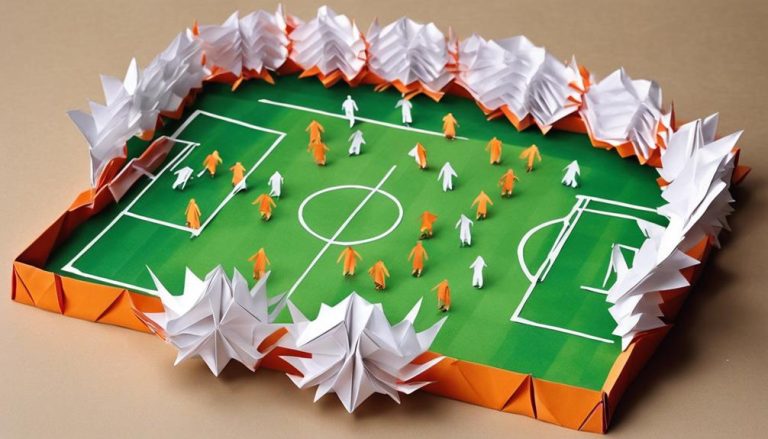General Rules of Hovercraft Racing
Looking for an edge in hovercraft racing? Stick to the track limits and course markings. Adjust your strategy for changing weather. Safety gear and emergency procedures are key. Make sure your craft passes inspections. Learn the flag signals for safety. Prepare well for the start and check your equipment thoroughly. Manage your points wisely and stay consistent for scoring. There's a lot more to know to master the hovercraft racing rules and tactics.
Course Boundaries
When following the course boundaries in hovercraft racing, it's important to stay within the designated track limits to avoid penalties. Course markings play a significant role in guiding racers along the intended route. These markings are there not only for guidance but also to guarantee fair play and adherence to racing etiquette. As you navigate the track, pay close attention to these indicators to maintain a competitive edge while respecting the rules.
Furthermore, being aware of weather conditions is critical in hovercraft racing. Changes in weather can drastically alter track conditions, affecting how your craft handles and performs. It's crucial to adapt your racing strategy based on the prevailing weather to maximize your chances of success. Keep an eye out for any updates on track conditions to adjust your approach accordingly.
Passing Rules
When it comes to hovercraft racing, understanding the points on passing rules is essential. You'll need to master safe passing maneuvers, communicate effectively during passes, and always be vigilant to avoid collisions. These key points will help you navigate the racecourse successfully and safely.
Safe Passing Maneuvers
Guarantee safe passing maneuvers by upholding a clear line of sight and communicating intentions effectively with other racers. When overtaking, maintain proper speed control to ensure a smooth pass without endangering yourself or others. Strategic planning is key; assess the situation, anticipate movements, and choose your moment wisely to execute a successful pass. Consider the terrain and any obstacles that may affect your maneuver. Adjust your race strategy accordingly to capitalize on opportunities to overtake opponents. Remember, safety is paramount in hovercraft racing, so always prioritize clear communication and situational awareness to avoid collisions and ensure an exhilarating but secure racing experience.
Communication During Passes
To guarantee smooth and safe passing maneuvers during hovercraft races, clear communication among racers is essential for maintaining a secure and enjoyable racing environment. Effective communication strategies and adherence to racing etiquette are vital for a successful pass. Here are three key points to contemplate:
- Clear Signals: Use agreed-upon hand signals or radio communication to indicate your intentions to pass, ensuring other racers are aware of your actions.
- Team Coordination: Work with your team to plan strategic passing maneuvers, coordinating your efforts to maximize speed and efficiency while minimizing risks.
- Respectful Overtaking: Show respect for fellow racers by passing safely and cleanly, avoiding aggressive or dangerous moves that could lead to collisions.
Avoiding Collisions
Steering the course smoothly and safely in hovercraft races requires strict adherence to passing rules to avoid collisions. When overtaking another hovercraft, employing collision avoidance strategies is essential. Implementing a well-thought-out race strategy that includes tactical maneuvering is vital for a successful pass. Defensive driving plays a significant role in preventing accidents during these high-speed encounters. Keep a sharp eye on your surroundings, anticipate the movements of your competitors, and be prepared to react swiftly. Remember, in the heat of the race, maintaining control and following the passing rules can make all the difference between a thrilling victory and a disastrous crash. So, stay focused, stay alert, and race smart to stay ahead of the competition.
Safety Regulations
When it comes to hovercraft racing, ensuring the safety of participants and spectators is paramount. Here are three important safety regulations to keep in mind:
- Safety Gear: Before getting on a hovercraft, make sure you are equipped with all the necessary safety gear. This includes helmets, life jackets, and any additional protective equipment required for the race.
- Emergency Procedures: Familiarize yourself with the emergency procedures in place. Know how to signal for help, what to do in case of a hovercraft malfunction, and where the nearest emergency exits are located.
- Safety Inspections: Hovercrafts must undergo rigorous safety inspections before races to ensure they meet all necessary requirements. These inspections cover everything from the functionality of the hovercraft to the safety features installed.
Following these safety regulations is important to guarantee a secure racing environment for everyone involved. Remember, prioritizing safety not only enhances the overall racing experience but also prevents potential accidents and injuries.
Penalties and Disqualifications
Alright, let's discuss points – the backbone of hovercraft racing penalties and disqualifications. Points are vital in determining penalty guidelines and disqualification criteria for racers. Understanding how points are assigned and managed is essential for maintaining fairness and competitiveness in the sport.
Penalty Guidelines
In hovercraft racing, penalties and disqualifications serve as essential measures to guarantee fair competition and adherence to the rules. When it comes to penalty guidelines, here are three key points to keep in mind:
- Penalty Enforcement: Important and consistent enforcement of penalties is vital to maintain a level playing field for all racers.
- Appeals Process: Providing a clear and structured appeals process makes sure that any disputes regarding penalties can be resolved fairly and transparently.
- Penalty Severity: The severity of penalties should be proportional to the infraction committed, promoting a sense of accountability among participants.
Disqualification Criteria
Mastering the world of hovercraft racing requires a deep understanding of the disqualification criteria, vital for upholding the integrity of the sport. When it comes to disqualification, several factors can come into play. Adverse weather conditions can prompt exclusion to guarantee the safety of participants and maintain fair competition. Understanding race strategies is essential to avoid penalties that could lead to disqualification. Additionally, spectator involvement or interference can result in immediate exclusion to prevent any unfair advantages. Team tactics must adhere to the rules to prevent the risk of being disqualified. Being aware of these criteria and following them diligently is imperative for a successful and honorable hovercraft racing experience.
Starting Procedures
When preparing for a hovercraft race, ensuring that the starting procedures are executed smoothly can greatly impact your performance on the track. Here are three key aspects to think about:
- Starting Techniques: Mastering the art of launching your hovercraft efficiently can give you a competitive edge right from the start. Whether it's finding the best throttle position or adjusting your weight distribution, honing your starting technique is essential.
- Race Strategies: Developing a solid race strategy involves more than just pressing the accelerator. Understanding when to make decisive moves, how to navigate tight corners, and when to conserve energy are all part of a winning strategy that starts right at the beginning of the race.
- Pre-Race Preparations and Post-Race Analysis: The work doesn't begin and end with the race itself. Proper pre-race preparations, such as checking your craft and mentally visualizing the start, can set the stage for success. Additionally, conducting a thorough post-race analysis can help you learn from your performance and improve for the next race.
Equipment Requirements
To ensure a competitive edge in hovercraft racing, understanding the essential equipment requirements is vital for peak performance on the track. Before heading to the hovercraft racing circuit, thorough equipment inspection is a must. Ensuring that your craft is in top-notch condition will not only enhance performance but also prioritize safety on the track. Safety gear such as helmets, gloves, and protective suits are must-have essentials to protect yourself during high-speed races.
When it comes to racing strategies, having the right equipment can make all the difference. Aerodynamic design plays a significant role in how your hovercraft performs during races. Investing in a well-designed craft with sleek lines and efficient airflow can give you a competitive advantage over your opponents.
Race Format
Understanding the race format is essential for hovercraft racers aiming for success on the track. Here are three key elements to ponder when it comes to the race format:
- Pit Stop Strategy: In hovercraft racing, pit stops can make or break a race. Knowing when to pit, how long to stay, and what adjustments to make can greatly impact your position on the track, especially in changing weather conditions.
- Fuel Management: Efficient fuel management is pivotal for maintaining speed and endurance throughout the race. Balancing fuel consumption with performance is a delicate art that can give you an edge over your competitors.
- Team Tactics: Collaborating effectively with your team can lead to better race outcomes. Communication, coordination, and strategic planning are key components that can help your team navigate the race format successfully.
Marshalling and Flag Signals
Traversing the domain of hovercraft racing demands a sharp comprehension of marshalling and flag signals to ensure a safe and competitive racing environment. Flag etiquette plays a pivotal role in ensuring all participants understand the current status of the race. Each flag color conveys specific messages – from green signaling the start of the race to red indicating danger or a stop. Understanding these signals is essential for your safety and the smooth running of the event.
Marshalling procedures are equally significant. Before the race begins, marshals will guide you on where to position your hovercraft, ensuring a fair start for all competitors. They also oversee the race, intervening if any rules are violated or if there are safety concerns on the track. Respecting the directions of the marshals is key to avoiding penalties and ensuring a fair competition for everyone involved.
In the thrilling world of hovercraft racing, mastering flag signals and marshalling procedures is your ticket to an exhilarating and successful racing experience. Pay attention, follow the rules, and enjoy the adrenaline-fueled adventure on the hovercraft track.
Scoring System
Exploring the thrilling domain of hovercraft racing, the scoring system serves as the compass guiding competitors towards victory and glory on the track. To fully understand the intricacies of the scoring system, consider the following:
- Time Management: In hovercraft racing, time management is essential. Competitors must complete each lap within a specified time frame to earn points. This adds an element of strategy and precision to the race, pushing racers to find the balance between speed and control.
- Point Allocation: The scoring system in hovercraft racing typically awards points based on finishing position. First place often receives the highest number of points, with subsequent positions earning fewer points. This encourages racers to excel for the top spot in each race, intensifying the competition and excitement on the track.
- Consistency is Key: In hovercraft racing, consistency is paramount. Racers must maintain a steady performance throughout the race to accumulate points consistently. A single mistake can cost valuable points, emphasizing the importance of focus and skill in every lap.
Frequently Asked Questions
How Do Hovercraft Racers Navigate Through Different Types of Terrain on the Race Course?
When tackling varied terrain in a hovercraft race, you must remember: "Different strokes for different folks." Employing sharp steering techniques and adjusting speed appropriately will help you navigate the twists and turns with finesse.
Are There Any Specific Weight Restrictions for Hovercrafts Participating in Races?
When it comes to hovercraft races, weight restrictions are essential. Safety regulations often dictate the maximum weight allowed for hovercrafts. Make sure to check the specific requirements for your race to guarantee compliance.
What Kind of Training or Experience Is Required for Pilots to Participate in Hovercraft Racing?
To participate in hovercraft racing, pilots need to complete training programs to develop their racing techniques and skills. These programs focus on pilot qualifications and provide the experience necessary to navigate hovercrafts effectively on the racecourse.
How Do Hovercraft Racers Deal With Unexpected Obstacles or Challenges During a Race?
When you encounter unforeseen obstacles or challenges in a hovercraft race, depend on emergency maneuvers and rapid strategy adjustments. Effective team communication and problem-solving techniques are vital for traversing the course with skill and precision.
Are There Any Specific Rules or Regulations Regarding the Use of Technology or Modifications on Hovercrafts for Racing Purposes?
Are there constraints on technology in racing? Hovercraft racing rules allow adjustments for speed and agility. Strategize to maximize performance while upholding your craft. Routine maintenance guarantees peak condition for exciting races.






